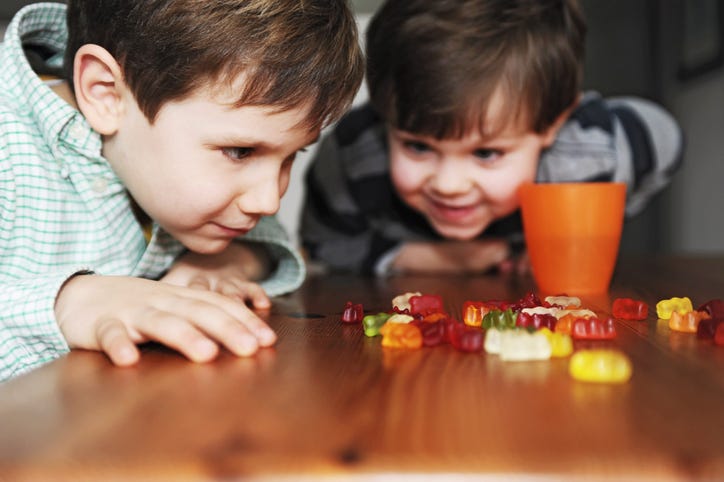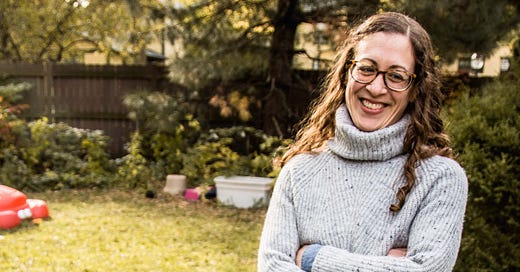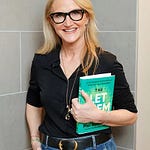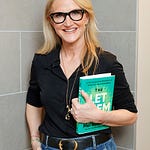NOTE: We're planning a special AMA episode of the podcast and we want your burning questions! Please submit your questions via this Google Form to help us stay organized.
Welcome to Burnt Toast! This is the podcast and newsletter where we talk about diet culture, fatphobia, parenting, and health. We don’t have a brand new episode for you today because I’m on spring break this week.
As many of you know, I used to co-host another podcast with my best friend Amy Palanjian, the creator of Yummy Toddler Food. Our podcast was called Comfort Food and we had to retire it in 2020, for a whole lot of reasons. Amy has given me her blessing to occasionally pull some of our best episodes and share them, which I’m really excited to do because there were a lot of great conversations. A lot of these are more parenting-focused, but I’m hoping everyone can get something out of it.
The episode I am sharing today first aired on March 5, 2020, right before the world shut down. Definitely do listen to this like you’re a historian, looking back at our earlier work. You can see where a lot of my thinking on these issues started—I don’t think I was all the way there yet. We’re all works in progress.
In particular, Amy and I were really just beginning to understand how we wanted to talk about kid diet culture on Instagram. You’ll hear moments where we’re both chafing against some diet mentality of our own. I think we do a pretty good job of naming those things as they come up, but I just want to be clear that I wouldn’t necessarily repeat all of this today and neither would Amy. If that makes you nervous or if you’re worried about potential for harm, certainly feel free to skip this one. We do talk about different forms of restrictive eating. If that’s something you’re interested in hearing and puzzling out with us and you bump on something as you’re listening, feel free to put it in the comments so we can discuss! I welcome that accountability and the chance to revisit and give you a take on where I would land now.

Episode 39 Transcript
Virginia
Hello and welcome to episode 65 of Comfort Food! This is the podcast about the joys and meltdowns of feeding our families and feeding ourselves.
Amy
This week we’re exploring how food restriction can creep into our everyday without us even really being aware of it, and the impacts that this can have on our own relationship with food and the way that we’re feeding our kids.
This topic has been on my mind lately because often when we talk about food restriction, we think of it as a calorie counting diet or strict portion control, but there are a lot of other ways that it can creep in and cause harm or confusion, or just make us not super clear on our goals with both how we eat and how we’re feeding our kids.
Virginia
Totally. I have also had those moments of kind of recognizing in yourself that this is a restriction thing. It can just pop up because it’s so conditioned into us. This might sound a little radical, but if you think back to like elementary school, when we were given the food pyramid—the food pyramid may not be the most harmful diet out there, but it still was like teaching us this hierarchy of foods, good and bad and less of this and more of that. It’s really difficult with kids who think so concretely in black and white about food, to tell kids how to eat in that way. Then we all grow up and get into diet culture, and more messages and more messages about restriction. So I think restriction is like at the core of how a lot of people interact with food in ways they just don’t even realize.
Amy
It’s extra hard, because as you’re talking about that my gut reaction is “but I want my kids to eat more nutritious foods.” How do you do that without limiting the other foods? Some foods tastes better than others and that’s the primary driver that kids have when they’re eating. They want it to taste good. They don’t have the capacity to understand about nutrients in different foods.
Virginia
Nor should they! That’s not an age appropriate expectation, that a six year old is like, “You know, what I’m worried about today? Cholesterol. What’s happening with my arteries in 40 years?” It’s not where we want their minds to go.
Let’s back up and talk about why restriction does backfire. Because some people listening may be thinking exactly like you, like "give me back my food pyramid or my ‘my plate’ or whatever, this is totally fine.
What we need to understand is that research shows over and over that the more limited you feel around a food, the more you feel like you don’t have permission to eat it, the more fixated on it you will be and the more you will crave it. Just saying to kids, “I want you to eat more fruits and vegetables” makes the fruits and vegetables less interesting. We can put in the show notes the famous study done by the iconic food researcher Leann L Birch, where they told half the kids in the study that they could have as much soup as they wanted, and then have dessert. And then they told the other kids you have to finish your soup before you’re allowed to have dessert. The kids who had to finish their soup, both ate less of it and liked it less than the kids who were allowed to self regulate between all the foods on offer. It’s a really powerful piece of research and it’s been replicated many, many times. It really showed that primary human psychology of feeling limited makes you crave it more. That is why this cannot be the way we approach nutrition with our kids.
Amy
What do you say to someone who doesn’t have a lot of understanding of nutrition, but they still want to raise their kids eating a “healthy” diet? How do you do it without having any of those boundaries?
Virginia
This is where I think Division of Responsibility is so helpful, because Division of Responsibility isn’t about good foods versus bad foods. Instead, it’s a way of feeding your family that lets kids play to their strengths. Kids, when left alone, really do know when they’re hungry and when they’re full. They will apply that knowledge to any type of food—even the “treat food” or higher flavor food, things that they’re really drawn to. None of us need nutrition degrees to feed our families. You don’t actually need to know all this nitty gritty about macros and micronutrients and potassium and sodium. All you need to know is that you’re in charge of offering a range of foods. That can mean lots of different things based on your budget, preferences, cultural values around food, whatever. You offer a range of foods, you’re in charge of what is served at the meal, and kids are in charge of how much they eat. That sounds overly simplistic—and of course, we’ve done plenty of episodes where we get into the nitty gritty of all of that—but fundamentally, that’s letting you bypass this whole issue of “is it nutritious enough?”
Amy
I’m on the same side as you, and I’m still like, “But wait!” On some level, it might be even easier if you didn’t have nutrition information.
Virginia
That is completely true. Let’s be real, when we say “nutrition information,” we don’t mean unbiased, exactly right, unequivocally true statements about food. We mean a whole mishmash of what we’ve learned in the media, what we read in diet books, what we’ve picked up from something a doctor said, something our mom said, something my neighbor said, my yoga teacher said such-and-such. All of this information in our brains about food is not all necessarily useful and it is really difficult to silence. I think that’s important to think about when you’re getting fixated on the nutrition piece. Is it really nutrition? Where are you getting those messages? Why does this feel so important?
Amy
When you are fixated on something, I think asking yourself, “What is my goal here?” When you’re worried about whether your kids eating enough protein, what’s the underlying goal? What’s your underlying worry?
Virginia
Because if you drill down into that, you may realize this is a restriction thing. This is actually me worrying about their body size or me worrying about whether I’m feeding them in a “perfect” way because I feel a lot of judgment about how I feed my kids. That’s not just basic nutrition, right? It’s often other anxieties we have that we’re filtering through this lens of wanting to control how our kids eat. It’s a way of spotting your own hidden restriction traps—which, to be clear, I have, too.
Amy
They’re never going away. It’s just a process of recognizing them.
Virginia
Recognizing them and then realizing you can let go a little bit. We had it just the other day. One of my daughters was eating some cookies with her afternoon snack, and we had bought the ones that come in little baggies of six cookies. She finished them and wanted more, and my husband was like, “But that was the portion.” And I was like, “Yeah, but that was just the portion the manufacturer decided. That’s not like some unequivocally correct amount of cookies for her. If she wants two more cookies, it’s fine.” These restriction traps come up all over the place, and social media does not help because they are everywhere.
Amy
So we’re going to share some other examples of where we’ve seen this and realized that there might be something else going on with restriction, just as a fun exercise.
Virginia
The first one is a message we have seen on Instagram where there’s a message that “processed foods will make kids feel grumpy.” What even are processed foods? That’s an enormous category. They all make kids grumpy? Bread? Everything makes kids grumpy? Those kinds of statements are definitely rooted in restriction because it’s definitely playing into good foods and bad foods.
Amy
That’s such a common belief, too. It’s hard. Even when you know that it’s not necessarily true, because those messages are just everywhere.

Virginia
This is one I see parents like apologizing for a lot. Like, “I can’t believe I’m letting them eat this,” or “I’m being such a bad mom today.” And this is where we have to push back because it’s not fair for moms or for dads to feel shamed about feeding kids perfectly nutritious and valid food choices because of this mysterious hype that doesn’t really make sense. I’m actually starting to dig in right now for my next New York Times column into the sugar high thing. Because none of this is cut and dry, it’s definitely not. It’s been interesting to look at the data and realize just how much myth goes into those kinds of messages.
Amy
Last week, I did an Instagram story on sodium because I was getting so many questions on it. That same day, I shared a snack plate of my three year old’s lunch. I looked at it and I was like, okay, so she basically hit her sodium, like a “maximum level,” in that lunch. Because there was cheese and there was crackers and there were veggie straws. But that’s actually the lunch that she ate, and she was happy. And that’s the lunch that I chose to give her. And it doesn’t mean that it’s wrong just because one of the nutrients is high. When you take that out of the context of the rest of what someone might be eating, it’s possible for any meal to look like it’s not balanced or “healthy.”
Virginia
You tell parents all the time to take the big picture view on their kid’s intake! Look over the course of a couple of days or a week to get a sense of how things are balancing out. Because unless you are an intense bodybuilder or Hollywood celebrity who has to control your nutritional intake to the gram, I don’t see why anyone needs to obsess over this to that degree. It’s not a happy or healthy way to live. I think a lot of us can recognize that and don’t want to go down that crazy path. It’s just hard in the moment. If your kids have a few snack-based meals for a few days in a row, and you suddenly think, wait, do I remember the last time they had a vegetable? Then you can spiral off.
Amy
The second example is one that has been really bugging me lately. This has come up maybe four times for me in the past month: that there’s only one right way to feed a baby. And that you 100% cannot do baby-led weaning and purees at the same time—I’ve actually had two different people say that to me, that you can’t do them both at the same time because you will confuse the baby. You’re basically putting the baby at risk for choking because they cannot possibly understand how to manipulate those two different foods at the same time. That’s not true.
Virginia
Why do these people think babies are so dumb? It feels very anti-baby. I have one child where baby-led weaning was the only option that was going to work for her and I had one child who was so ravenous that she needed purees because she lacked the motor skills to feed herself well enough. In both cases, we also basically did both at all times. Because, as humans, we do both, right? As an adult, I eat both solid and pureed food. I don’t know why you need to make this distinction.
Or you may have a kid who’s really not doing well with purees but doing great with self-feeding. Again, I had that child. There’s definitely going to be kids on the extremes that need one approach or the other. But that doesn’t mean that that’s the only way to do it.
Amy
A lot of the supporters of baby-led weaning feel that it is the right way to start solids and if you do that, you are going to set your kid up to be a healthy eater. You’re not going to have a picky eater and you’re going to have a perfect child. No matter how you feed a baby, they’re going to get to be one and a half or two, and they’re going to hit that developmental stage where they’re fearful of new foods. I don’t care what they ate when they were nine months old, it’s not going to be the same.
Virginia
The pressure we’re putting on ourselves! It’s not a realistic expectation to think that your child will never ever be a picky eater, because being picky is part of having preferences and will. As frustrating as it is for all of us, it’s normal for toddlers to go through this because it’s how they’re becoming independent people. And we want that for our children!
So number one, let’s stop making picky eating the enemy of everything, because it is part of normal child development. But also, I think you’re totally right. This ties into needing to raise a “perfect” eater and this idyllic, perfect nutrition at every meal type of approach. It’s so much pressure on yourself, it’s so much pressure on your kid. It’s not realistic, it’s not sustainable. There’s just so many other ways to measure yourself as a parent. You are not how your child eats.
Amy
This falls into the category of restriction because you’re putting up these artificial boundaries on what’s right and what’s not right.
Virginia
Totally agree. If you’re literally saying, “I’m not going to spoon feed my child yogurt,” that is a restriction you are making that may at times be quite inconvenient.
Amy
Or you have a child who goes to daycare and that’s the way they feed them! You may not always have the choice.
Virginia
You’re setting up a certain inflexibility. I’m painting with a broad brush, but I do see a certain trajectory between the parents who are very hardcore about baby-led weaning, who then pack the rainbow bento lunchboxes, who then also don’t let sugar in the house. This can be putting you down a whole path of being very controlling about how your kid eats.
Amy
Yeah. And just to say this again, we empathize if that’s where you are because it’s so easy to find yourself there.

Virginia
Yeah. Feel free to read chapter one of my book, you guys. It’s free on my website. I was there with you in a pretty intense way.
The next one that we have noticed is definitely pretty clear cut restriction. It’s when you see pictures on social media, of kid meals and they’ve added a portion of dessert or fun food and it’s like three M&Ms in the lunchbox around the dinner plate. I think people really believe in their hearts that that is an appropriate portion size for a kid. I remember struggling because I would see this all the time and I would think, oh, yeah, they only need three M&Ms. And my kids would just inhale three M&Ms and look at me like, why are you not giving me more M&Ms? Nobody is satisfied by three M&Ms. What’s underlying this is that you are anxious about giving them a treat food and you’re trying to control how much of it they eat. With Division of Responsibility, you stay in your lane. You’re blurring responsibilities there. You need to give them a little more freedom to decide. Maybe it’s six M&Ms or twelve. Or, you don’t count the M&Ms! That’s also an option.
Amy
The thing that can be hard about this is Ellyn Satter says to give dessert with dinner and give one portion. Well, what’s the portion? Is this portion the same for me as it is for my child? Is it the same for an 18 month old as it is for a five year old? That’s a lot of choices that you need to make.
Virginia
I disagree with this piece of Ellyn Satter. I think it is too confusing for parents. You do then get really hung up on portion size. I think it’s better to put out something that you can all share on the table and let the kids still help themselves to how much it is. Maybe you don’t put out 1,000 brownies, but you put out a plate so that everyone’s going to have one or two. Getting hung up on the different portion sizes for your 18 month old versus your six year old sounds crazy-making.
Amy
We often have dessert with dinner and I often force myself to make the portion larger than I think it should be as a way to get myself out of the habit of trying to control how much of the dessert that they get.
Virginia
Fighting back against your restriction, I like it.
Amy
It’s a very interesting. Last weekend I made rice krispies treats in a 9x11 baking pan. I remember very clearly standing there and debating how big to cut them. Then I was like, you know what? I’m gonna cut them as big of a size as I would want my rice krispies treat to be. That probably wound up being less bars than specified in the recipe. Everyone wound up having two and it was fine! Just be aware of what comes up. It can be a very, very interesting and eye opening experience to consider. And the same thing with ice cream!
Virginia
Yeah, I admit, we do tend to serve ice cream in smaller bowls, mostly because ice cream is expensive and I want the pint to last a little longer. There’s probably also some restrictive mindset of thinking surely they don’t need a full cereal bowl size. I think that the Satter advice of “serve one portion of dessert with dinner” is great if you are consistently serving dessert every single night with dinner. There’s always a treat food on the table and your kids can trust and rely on that. Then you could have it just be one thing because they know they’re gonna get more tomorrow. You’re not going to trigger the scarcity mindset. Whereas if you serve dessert a little more infrequently, I would probably peel back on needing to control the portion. View this as a learning opportunity for everybody to learn how much they want to eat cookies or ice cream or whatever, which she also does say you should do from time to time.
Because we don’t tend to do it every single night, I take that approach of letting them regulate their own portion. And I definitely see them leaving stuff in the bowl. Some nights they want a lot and some nights they don’t really care about it. We’ve avoided the restriction of mindset there. I think if you find yourself counting M&Ms or really struggling, do exactly what Amy’s doing. Err on the side of giving more and just be curious about what happens.
Amy
My overall goal is to expose and offer my kids a range of foods throughout the week. That includes all sorts of vegetables and produce, all sorts of food groups, and also to have these moments of food that is purely for pleasure. Aim for a mix of all of those experiences, so that at the end of the week, they’ve had a lot of different food types, and not to get caught up in the counting. That’s why it’s hard for me when people ask me about appropriate portion sizes. My answer is to always trust your child’s hunger and that is not a satisfying answer for a lot of people.
Virginia
Because they are still working through their own restrictive mindset.
Amy
And because that’s the cultural norm! Someone was telling me the other day that they went to their pediatrician and their pediatrician actually recited the Division of Responsibility to them, and I was like in Des Moines? Somebody knows what that is? I was so shocked. I’m going to drive an hour now to go find that person. That’s the first time I’ve ever heard a medical provider even know what that was.
Virginia
You’re definitely fighting some bigger cultural stuff. We can also put a link in to my column from December because I did get into a little more of the research supporting it. That’s a good thing to have handy if you are getting some pushback from doctors or other family members. I often hear from, interestingly, mostly women saying, “How do I explain this to my husband?” This article is a useful link to share. It can help explain why you are relaxing about portion size. If we are having a fun food experience, the first thing that kills the fun food experience is worrying about portion control.
Amy
Do you want to share a tip for, when we’re looking at health information or food or things we see online, how to spot this sort of thing? How to evaluate whether it’s information that we want to take in?
Virginia
If we’re talking about social media posts, I would say—I mean, Amy’s photography is lovely, so lovely photography is not an automatic reason to write it off. But, a photo that is hyper styled, hyper controlled, everything in the box or on the plate, and perfectly portioned out in this really beautiful jigsaw puzzle way, I think it’s a sign that they made that meal to shoot a photo and not to feed to an actual child. There’s probably some other stuff going on in the advice that’s not about what you actually need to think about with your kids.
A great thing about social media is it has given more attention to things like division of responsibility, so there are a lot of people talking about it now, which is awesome. There are also plenty of people using those concepts to promote a diet mindset. If you see somebody claiming to be intuitive eating or division of responsibility but also talking about controlling a portion for food for a child, that’s a big red flag, because that goes against both of those concepts. Overly obsessing about different types of micronutrients and macronutrients, anything that feels like it’s really, as Leslie Schilling would call it, “health propaganda,” versus basic advice about how to feed your kids.
Amy
We got this really awesome question from a listener. They have twins who are a little over two years. They do division responsibility. They’ve tried family style, they’ve done deconstructed meals, they try to always have one food on the table that the kids like. They’ve put at least two hours between snack and dinner and they sit down together. Basically, like, they’ve done all the things. A+, gold star students. Great family meals. But then the kids don’t want the food. They will sometimes eat plain rice or bread. She and her husband are underwhelmed by the meals because there’s a lot of leftovers and food waste. So, she’s gone back and forth between trying to make a meal the kids will like and trying to make a meal that she’ll like.
At the end of the day, the kids still aren’t eating a lot. I think at the root of this, she—and often I and many parents—feel like they’re failing and that they’re not doing family dinner the right way. For some reason, they just can’t figure out what to feed their kids. Which is where I would say, it is 100% possible that your kids are just not hungry for dinner. That is a really, really normal thing. And which can make you also feel like you’re failing because nobody wants to send their kid to bed on an empty stomach. But it’s normal.
Virginia
It’s so normal and it comes in phases. Beatrix is right around the same age as these twins. And oh, dear listener, I am right there with you. She is so over dinner right now. Basically, I feel like I could set a watch for five minutes and both of my children would be gone from the table before the timer went off. That is what’s happening with dinner right now. We sit down, they eat like three bites, and then they’re both like ping pongs, just gone. Because they’re over it! They want to go play. They’re just not in a super hungry for dinner phase. A lot of it is in our schedule, they are having snacks closer to dinner. They’re both ravenous at 3:30-4:00 and so by 5:30 they’re actually not that hungry anymore. So it is what it is right now.
Amy
I ask, “How are the rest of their meals? Are they eating well, the rest of their meals? Are they meeting their milestones and gaining weight? Do they generally seem happy? Do you feel in your mama gut that something is wrong? Or does it seem like they’re not hungry?” The last thing they want to do is to work at eating something that they may not be super familiar with. They may just legitimately not be physically hungry. But that’s not a common message that we’re given.
Virginia
Definitely not. Just as you were running down that list, I was like, yep we’re fine on milestones, we’re fine on all that. She’s not eating a ton in general. She’s also getting over a cold like, I think her two year molars were coming in. There’s a lot of things that can just throw off eating for a short period of time that you don’t need to panic about. You just had this with your kid being sick and giving up on solids and then bouncing right back once he felt better. If that’s going on, don’t stress. The times to stress are when you feel like you’ve only got a handful of foods that they’ll consider and you’re worried about their growth and milestones. It is important to take that big picture view.
Amy
Yeah. I like to remind people and also myself that Tula basically didn’t eat dinner for the entirety of her two year old year. She just wasn’t interested in it. And now she’s like, maybe 50/50. She will very happily stand in her Learning Tower to help me chop vegetables, and she’ll eat a pepper and then like that will be her dinner. Like, even if there’s pasta, she’s just not super hungry at that time in the day. So, public service announcement: you’re not doing anything wrong. This is a normal phase of childhood. It may come and go. They may go through months where they’re inhaling dinner. And then it may back up again and not be much. Keep it in perspective and trust that. Don’t make it your job to get them to eat a certain amount of food. Make it your job to give them the opportunity and then trust whether or not they eat.
Virginia
This may even be a time where you decide you are going to do a simple kid dinner early and then eat what you and your husband really want after they’re in bed. It’s completely valid if it’ll help reduce your food waste and your stress. Maybe try that out for a few weeks and see how that feels. Make a different meal of the day your family meal and worry less about the dinner piece. I would also say this is definitely a “feed yourself first” moment. Pick the meals you want keep offering, the one or two safe foods you know that they’ll eat if they are hungry. There’s bread or whatever on the table they can go for. But don’t kill yourself making meals that are overly catering to them and then feeling sad about what you’re having to eat.
Virginia
Thanks so much for listening to Burnt Toast and that flashback episode to Comfort Food March 2020. I hope you enjoyed it! I would love to hear your thoughts.
If you’d like to support the show, please subscribe for free in your podcast player or tell a friend about this episode.
The Burnt Toast Podcast is produced and hosted by me, Virginia Sole-Smith. You can follow me on Instagram or Twitter.
Burnt Toast transcripts and essays are edited and formatted by Corinne Fay, who runs @SellTradePlus, an Instagram account where you can buy and sell plus size clothing.
The Burnt Toast logo is by Deanna Lowe.
Our theme music is by Jeff Bailey and Chris Maxwell.
Tommy Harron is our audio engineer.
Thanks for listening and for supporting independent anti-diet journalism.














Share this post